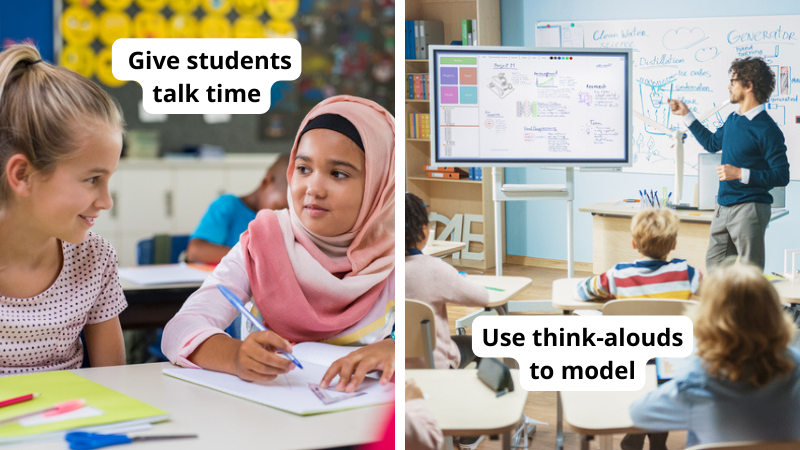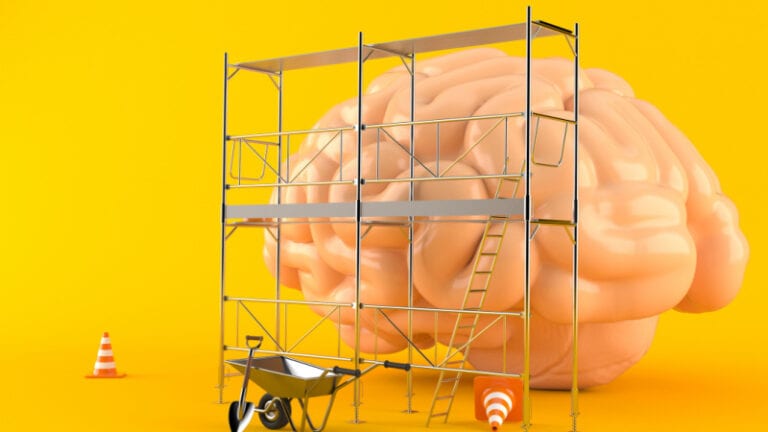Providing students with better instructional scaffolding is often a schoolwide objective, but how can school leaders and teachers put this big idea into practice? Imagine someone plopping a giant box of odds and ends in front of you and telling you to figure out what to do with them with no further instructions. Without being told the purpose of the activity, specific expectations, or background information, it would be overwhelming and discouraging to say the least. Almost all students, particularly those with unique learning needs, have felt exactly this way in the classroom at one time or another. Luckily there are many strategies educators can use to help students, and among the most important is scaffolding.
Below you’ll learn more about scaffolding in education, including 18 effective ways to scaffold learning. If you’re a teacher, integrate these as best practices, and observe their impact. If you’re an administrator, share these practices with your teachers, and look for them during classroom walk-throughs.
What is scaffolding in education?
Scaffolding is a way to provide support for students by breaking down learning into manageable chunks as they progress toward stronger understanding and ultimately greater independence. In other words, it’s a way for teachers to provide support while students master new concepts and skills.
The strategy is based on the work of Russian psychologist Len Vygotsky, whose theories stress the fundamental role of social interaction in cognitive development. He theorized that children learn best when they interact with other people, particularly more knowledgeable people, who provide guidance and encouragement to master new skills.
Using the much-lauded concept the Zone of Proximal Development, teachers can guide, support, and encourage students as they help them develop problem-solving strategies that can be generalized to other situations.
Scaffolding Strategies
1. Teach mini-lessons
Break down new concepts into bite-sized pieces that build on one another. Teaching a series of mini-lessons provides students with a safety net that moves them progressively toward deeper understanding.
Learn more: Essentials of a Mini-Lesson
2. Use explicit instruction
One of the best practices in supporting learners is the use of systematic, explicit instruction. That is, instruction that includes clear modeling, think-alouds, and multiple examples, which are described in greater detail below. In addition, immediate corrective feedback is critical. Catching students’ errors while they’re still practicing will prevent them from learning the skill incorrectly and then continuing to practice it incorrectly for homework and on other assignments.
Learn more: Explicit Instruction: Best Practices for Teaching Math to Unique Learners
3. Use think-alouds to model or demonstrate
One of the best ways to scaffold learning is to show your students an example of what they will be learning. For example, demonstrate a science experiment so they can see how it’s done before they do it themselves. Or gather them on the rug and let them watch you solve a math problem in a new way. Verbalize your thought process as you demonstrate. Use a think-aloud strategy to give your students a model for an inner dialogue they can copy.
Learn more: Improve Reading Comprehension With Think-Alouds
[contextly_auto_sidebar]
4. Describe concepts in multiple ways
Support different learning styles by approaching new concepts from multiple angles. Show them, tell them, and let them try it for themselves. The more ways you approach learning, the more sense it will make for students.
Learn more: Different Learning Styles: What Teachers Need To Know
5. Break large tasks into smaller steps
Sometimes it’s hard for students to remember all the steps they have to follow for an assignment. Scaffold learning by breaking down directions into chunks that students can complete one step at a time. Give them a checklist that they can follow. By breaking it down, you’re providing scaffolds that students need.
Learn more: Chunking Information for Instructional Design
6. Slow down
Here is some great advice from elementary teacher Tammy DeShaw. “We move so fast as teachers because we fear that we won’t get through it all,” she says. “But when we slow down and give students more time to process, we are really helping students. It is an effective scaffolding strategy when we pause at various points of instruction and break it up. Think about it. If something is above your head, it’s immediately overwhelming. But if you break it into manageable chunks and take your time through it, you’re able to process it much better!”
Learn more: Scaffolding Strategies
7. Incorporate visual aids
Show a video, pass out colorful images, or provide a concrete object to start off a new lesson. For example, if you’re teaching a lesson on polyhedrons, place models of different types on tables for students to see and touch.
Learn more: Making the Most of Visual Aids
8. Front-load concept-specific vocabulary
Arm students with specific academic language they will need to understand ahead of time so that vocabulary doesn’t become a stumbling block to higher-level learning.
Learn more: Pre-Teach Vocabulary
9. Activate prior knowledge
Show students the big picture. Make connections to concepts and skills students have already learned. Connect to experiences they have had, such as field trips or other projects.
Learn more: Teaching Reading Strategies: Activate Prior Knowledge
10. Give students talk time
Be sure to give kids plenty of time to process new information by partnering them up or breaking them into small groups. Have them articulate concepts in their own words to one another. Come back together as a whole group and share any insights that might be helpful to everyone.
Learn more: Cooperative Learning Structures: Fun Alternatives to Think-Pair-Share
11. Give students time to practice
After you model learning for your students, take some time to practice with them. Have a few students come up to the board and try a math problem. Or write a paragraph together on chart paper. Think of this guided practice as a series of rehearsals before the final performance.
Learn more: The I Do, WE Do, YOU Do Model Explained
12. During lessons, check for understanding
Check in often to make sure students are with you. A simple thumbs-up, a sticky note check-in, or a desktop flip chart are a few of the ways you can check for understanding. See who’s good to go, who’s almost there, and who needs some one-on-one.
Learn more: Creative Ways To Check for Understanding
13. Use graphic organizers
A graphic organizer is a powerful visual learning tool that teachers can use to help students organize their thinking before, during, or after a lesson. They are a great way for students to classify and communicate their ideas more effectively. A simple Google search will connect you to all kinds of printable graphic organizers that you can customize to the material you are teaching.
Learn more: Graphic Organizers 101
14. Try sentence starters
Sometimes a head start helps students gather their thoughts. Provide students with the first part of a statement and ask them to fill in the blanks. Sentence starters can be an especially great support for English-language learners.
Learn more: Using Sentence Stems in the Classroom
15. Coach students to help each other
When learning a new concept or reading a difficult passage together, call on a strong student to answer a question. Then, call on another student to repeat, in his or her own words, what was just said. By listening and repeating, you reinforce your students’ understanding.
Learn more: Fun Ways To Help Your Students Collaborate in the Classroom
16. Set clear expectations
Students (like most of us) perform better when they fully understand what is expected of them. Describe the purpose of the assignment, and give them concrete examples of the learning goals they are expected to achieve. Give them clear directions and show them exemplars of high-quality work. Finally, provide them with a rubric so they know exactly what to do to successfully master the concept.
Learn more: Developing Clear Expectations for Learning
17. Ask open-ended questions
Another important tool we have is questioning. Asking questions allows students to organize their thoughts and elaborate on their processes. The key is making sure you ask meaningful questions. Make sure they can’t be answered with a simple yes or no. In addition, the questions you ask should require reflection. And finally, questions should direct students to important, pivotal aspects of the task they are working on.
Learn more: Instructional Scaffolding Strategies
18. Use technology
Technology can help simplify the scaffolding process. Make playlists of lecture videos for students to watch before the lesson. This will allow them to preview the material and be ready to engage with the content in class. Another tip is to provide links to websites that have different ways to engage with the content, such as videos, games, articles, or demonstrations.
Many online curriculum programs are adaptive, meaning they can assess what a student knows and what information they need next. This allows students to follow a personalized learning path toward meeting learning objectives.
Learn more: Using Technology to Scaffold Student Learning
Does scaffolding learning really work?
Overall, scaffolding is an extremely effective instructional strategy when both administrators and teachers embrace and implement it consistently. But like any teaching strategy, scaffolding has its benefits and challenges.
Benefits of scaffolding:
-
- Promotes a positive learning environment because students feel supported and are able to ask questions, encourage their classmates, and offer their opinions.
- Builds students’ confidence as they progress to more difficult tasks.
- Leads to higher engagement, which motivates students to learn more on their own.
- Improves comprehension and problem-solving.
- Allows teachers to move to a facilitator role, guiding students to take ownership of their own learning.
Challenges of scaffolding:
- Takes more planning and is more time-consuming as teachers need to evaluate lessons and figure out where scaffolding is needed.
- Finding appropriate scaffolds that match the diverse learning and communication styles of students.
- Correctly identifying students’ zone of proximal development.
- Knowing when to taper off and allow students to work independently.
- Releasing more responsibility to students.
How do you scaffold learning for your students? Come share in our WeAreTeacher Helpline group on Facebook.
Plus, check out these Creative Ways To Check for Understanding.



